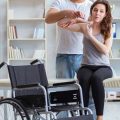Overview of Spine Injuries and Rehabilitation Challenges
Spine injuries are a significant health concern in the United States, affecting thousands of people each year. These injuries can result from car accidents, sports activities, falls, or even everyday movements gone wrong. Understanding the different types of spine injuries and how they impact daily life is essential for appreciating the challenges faced during rehabilitation.
Common Types of Spine Injuries in the U.S.
| Type of Injury | Description | Typical Causes |
|---|---|---|
| Herniated Disc | When a spinal disc ruptures or slips out of place, causing pain and nerve issues. | Lifting heavy objects, aging, sudden trauma |
| Spinal Fractures | Breaks or cracks in the vertebrae, often leading to instability. | Car accidents, falls, osteoporosis |
| Spinal Cord Injury (SCI) | Damage to the spinal cord itself, which may cause paralysis or loss of sensation. | Severe trauma, sports injuries, violence |
| Spondylolisthesis | A vertebra slips out of position onto the bone below it. | Degeneration, congenital defects, stress fractures |
| Whiplash | Soft tissue injury in the neck and upper spine area. | Rear-end car collisions, sports impacts |
The Impact on Daily Life
Living with a spine injury can make daily tasks challenging. People might experience chronic pain, limited mobility, muscle weakness, and even difficulties with balance and coordination. Everyday activities like walking, dressing, working at a desk, or driving can become difficult or impossible without support. These physical challenges can also affect emotional well-being and social life.
Unique Rehabilitation Challenges
- Pain Management: Persistent pain can slow down progress and reduce motivation for therapy.
- Limited Mobility: Some patients need assistive devices or adaptive equipment just to move around safely.
- Nerve Damage: Injuries that involve nerves may lead to loss of sensation or movement in parts of the body.
- Mental Health: Anxiety and depression are common due to lifestyle changes and loss of independence.
- Long-Term Recovery: Rehabilitation for spine injuries is often a long process requiring consistent effort and access to specialized care.
The Role of Innovative Technologies
The complexity of these challenges highlights why innovative technologies are so important in orthopedic rehabilitation. New tools and techniques are helping patients regain function faster, manage pain better, and improve overall quality of life. As we explore these advancements in upcoming sections, we will see how technology is making a real difference for people recovering from spine injuries across America.
2. Emerging Digital Tools in Orthopedic Rehab
Wearable Sensors: Real-Time Feedback for Better Recovery
Wearable sensors are becoming game-changers in spine injury rehabilitation across the United States. These small, lightweight devices can be worn on the body to track a patients movements and posture during daily activities or therapy sessions. Physical therapists use the data collected by these sensors to monitor progress, spot incorrect movements, and adjust rehab plans for better results. For example, many American clinics now offer sensor-equipped vests or bands that send real-time feedback to both patients and therapists, making it easier to stay on track even at home.
Popular Wearable Sensor Features
| Feature | Description |
|---|---|
| Posture Tracking | Monitors spinal alignment and body position throughout the day |
| Activity Monitoring | Records steps taken, time spent standing or sitting, and exercise reps |
| Real-Time Alerts | Sends notifications if unsafe movements or poor posture are detected |
| Progress Reports | Provides easy-to-read summaries for patients and clinicians |
Motion Tracking Apps: Home Rehab Made Easy
Motion tracking apps are helping Americans with spine injuries continue their rehab from the comfort of home. Using just a smartphone or tablet camera, these apps analyze how users move during exercises. They give instant tips to correct form and keep patients motivated. Many apps also allow users to send their performance data directly to their care team. This digital connection means therapists can personalize rehab routines without needing frequent office visits.
Benefits of Motion Tracking Apps
- User-friendly interfaces make them accessible for all ages
- No special equipment required—just a phone or tablet
- Visual guides help prevent common mistakes during exercises
- Secure sharing of progress with healthcare professionals
Tele-Rehabilitation Platforms: Connecting Patients and Therapists Nationwide
Tele-rehabilitation, often called “tele-rehab,” has become increasingly popular in the U.S., especially after the COVID-19 pandemic. These online platforms let patients have virtual appointments with orthopedic specialists using video calls. Through tele-rehab, therapists can demonstrate exercises, check technique, and answer questions in real time. This technology is especially valuable for people who live far from medical centers or have limited mobility due to spine injuries.
How Tele-Rehab Supports Spine Injury Recovery:
- Convenience: No need to travel long distances for appointments.
- Accessibility: Reaches rural areas where in-person rehab may not be available.
- Consistency: Helps maintain regular check-ins and adjustments to therapy plans.
- Family Involvement: Allows caregivers to join sessions for extra support.
Together, these emerging digital tools are making orthopedic rehabilitation for spine injuries more accessible, effective, and personalized for American patients than ever before.

3. Robotics and Exoskeletons for Spine Recovery
Revolutionizing Mobility with Robotics and Exoskeletons
In recent years, robotics and exoskeletons have become game-changers in orthopedic rehabilitation for spine injuries. These innovative technologies are helping people regain movement and independence both in clinical settings and at home. Let’s explore how they work and why they matter.
How Robotic-Assisted Therapy Helps
Robotic-assisted therapy uses advanced machines to guide and support patients through controlled movements. This technology is especially helpful for individuals who have limited mobility after a spinal injury. The robot provides just the right amount of assistance, allowing patients to practice walking, balance, and strength exercises safely and effectively.
Key Benefits of Robotic-Assisted Therapy
| Benefit | Description |
|---|---|
| Consistent Movement | Robots deliver repetitive, precise motions that help retrain the body more efficiently than manual therapy alone. |
| Real-Time Feedback | Patients and therapists receive instant data on progress, making it easier to set goals and track improvements. |
| Motivation Boost | Interactive features can make rehab more engaging, encouraging patients to stay committed to their recovery. |
The Power of Exoskeletons in Spine Rehabilitation
Exoskeletons are wearable robotic devices that support or enhance a person’s movements. For those recovering from spine injuries, exoskeletons can make standing up and walking possible—even when traditional therapy falls short. They are designed to fit around the legs and torso, providing powered assistance as the user moves.
Clinical vs. Home Use: What’s the Difference?
| Setting | Main Advantages | User Experience |
|---|---|---|
| Clinical Setting | Supervised by medical professionals; customized therapy plans; access to high-tech equipment. | Safe environment for learning new skills; regular monitoring; team support. |
| Home Setting | Greater independence; ability to practice daily activities; convenience of use at home. | Boosts confidence in everyday life; encourages continuous progress outside the clinic. |
Making a Real Impact on Daily Life
For many Americans with spine injuries, robotics and exoskeletons are not just about technology—they’re about hope. These tools give people the opportunity to move again, improve their quality of life, and reclaim independence. Whether it’s walking across the living room or participating in physical therapy sessions at a rehab center, these innovations are opening doors that were once closed.
4. Virtual Reality and Gamification in Therapy
Virtual reality (VR) and gamified exercises are transforming orthopedic rehabilitation for spine injuries in the United States. These technologies bring a new level of excitement, interaction, and motivation to therapy sessions, making them more effective and enjoyable for patients.
How VR Works in Spine Rehab
In a typical VR-based rehab session, patients wear a headset that immerses them in a digital environment designed for therapeutic movement. This environment can simulate real-world activities or present fun challenges like balancing games or virtual sports. Therapists can adjust the difficulty based on each patient’s needs and progress.
The Power of Gamification
Gamification means turning rehab exercises into games with points, levels, rewards, and instant feedback. For example, instead of simply asking patients to reach forward or twist their torso, therapists can have them “collect coins” or “navigate mazes” within a game. This approach makes repetitive movements less boring and helps patients stay motivated over time.
Main Benefits for Patients
| Benefit | Description |
|---|---|
| Increased Engagement | Patients are more likely to participate fully when therapy feels like play rather than work. |
| Better Motivation | Game-like features encourage patients to push themselves and return for future sessions. |
| Real-Time Feedback | Immediate scoring and progress tracking help patients see how they’re improving. |
| Customized Experience | Therapists can tailor activities to match individual needs and abilities. |
| Safe Practice | Virtual environments allow patients to try movements without risk of injury. |
American Examples in Practice
A growing number of rehab centers across the U.S. are adopting VR systems like Reflexion Health or MindMaze. These platforms often include sports themes or American landscapes to create a familiar, motivating experience for local patients. By using technology that feels both high-tech and relatable, clinics help patients build confidence while recovering from spine injuries.
5. Personalized and AI-driven Rehab Interventions
AI-Powered Analytics in Spine Injury Rehabilitation
Artificial Intelligence (AI) is transforming orthopedic rehabilitation for spine injuries across the United States. By using advanced data analytics, AI helps clinicians create personalized treatment plans that are tailored to each patient’s unique needs, lifestyle, and recovery goals. These smart systems analyze a wide range of factors—from medical history and injury type to mobility data and real-time feedback—so that rehab professionals can make better decisions, faster.
How AI Improves Patient-Centered Care
Patient-centered care means putting the patient’s preferences, progress, and goals at the heart of every decision. In spine injury rehab, AI-driven platforms are making this easier than ever before. Here’s how:
| Feature | Benefit to Patients | How It Works in Rehab Centers |
|---|---|---|
| Predictive Outcome Modeling | Sets realistic expectations for recovery timelines | AI analyzes similar cases to estimate potential outcomes and risks |
| Personalized Treatment Algorithms | Treatment adapts as patients progress or face setbacks | Plans update automatically based on daily performance and feedback |
| Remote Monitoring & Feedback | Makes home-based rehab safer and more effective | Sensors and apps track exercises, sending data back to therapists in real time |
| Data-Driven Motivation Tools | Keeps patients engaged with visual progress tracking | Gamification elements and progress dashboards encourage participation |
The Growing Role of AI in U.S. Rehab Practices
Across the U.S., top rehab centers and clinics are integrating AI solutions into their everyday workflows. Whether it’s predicting which therapies will work best or identifying early warning signs of complications, these technologies help ensure that each patient gets the right care at the right time.
A Look Ahead: What Patients Can Expect Next
As AI tools become more widespread, patients recovering from spine injuries can expect even more customized rehab experiences. With ongoing innovation, the future of spine rehabilitation is not just high-tech—it’s highly personal.


